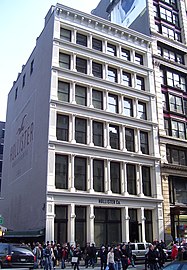Samuel A. Warner: Difference between revisions
Tags: Mobile edit Mobile web edit |
Tags: Mobile edit Mobile web edit |
||
| Line 49: | Line 49: | ||
| alt3= |
| alt3= |
||
| File:Our Lady of Peace Church 239-241 East 62nd Street.jpg |
| File:Our Lady of Peace Church 239-241 East 62nd Street.jpg |
||
| [[Church of Our Lady of Peace|Presbyterian Church of the Redeemer]] (now [[Our Lady of Peace Church|Our Lady of Peace Church (Roman Catholic)]]<br>(1886),<br>239-241 East 62nd Street,<br>Manhattan, New York City |
| [[Church of Our Lady of Peace|Presbyterian Church of the Redeemer]] (now [[Our Lady of Peace Church|Our Lady of Peace Church (Roman Catholic)]]<br>(1886-1887),<br>239-241 East 62nd Street,<br>Manhattan, New York City |
||
| alt4= |
| alt4= |
||
| File:428 Broadway.jpg |
| File:428 Broadway.jpg |
||
Revision as of 17:40, 20 October 2024
Samuel A. Warner | |
|---|---|
| Born | Samuel Adams Warner 1822 |
| Died | 1897 (aged 74–75) |
| Occupation | Architect |
| Buildings | |
| Father | Cyrus Lazelle Warner (1789-1852) |
Samuel Adams Warner (1822–1897) was an American architect.[1] He studied architecture in his father Cyrus Lazelle Warner (1789-1852)'s office and partnered with his younger brother Benjamin Warner from 1862 to 1868. He designed dry goods merchant buildings for the H.B. Claflin Company, S.B. Chittendon & Company, Charles St. John, and H.D. Aldrich. He also designed the Marble Collegiate Church and several buildings in the SoHo neighborhood of westside Lower Manhattan in New York City's now designated Soho-Cast iron Historic District with significant examples of Cast iron architecture from 1879 to 1895.[2]
Benjamin Warner is credited with designing 33 Greene Street at the northwest corner of Grand Street in 1873.[3]
Work
- Samuel Adams Warner House (1875), the architect's home, which he designed, further east in Roslyn, New York (Nassau County on the North Shore of Long Island).
- Marble Collegiate Church (1851–1854), a Gothic Revival architecture structure of an inter-denominational Protestant Christian church, at 1 West 29th Street on the northwest corner of 5th Avenue in Manhattan of New York City[3]
- Presbyterian Church of the Redeemer (now Our Lady of Peace Roman Catholic Church) (built 1886–1887) at 239 East 62nd Street (between 2nd Avenue and 3rd Avenue), in Midtown Manhattan of New York City[3]
- 16-18 Greene Street, Manhattan, New York City[3]
- 20-26 Greene Street (1880), Manhattan, New York City [3]
- 39-41 Worth Street[3]
- 600 Broadway (1884)[3]
- 545 Broadway (1885)[3]
- 426-432 Broadway (1888-89)[2]
Gallery of buildings designed by Samuel A. Warner
-
23 & 25 Park Place (1856)
-
Presbyterian Church of the Redeemer (now Our Lady of Peace Church (Roman Catholic)
(1886-1887),
239-241 East 62nd Street,
Manhattan, New York City -
428 Broadway (1888)
-
600 Broadway (1884)
![]() Media related to Samuel A. Warner at Wikimedia Commons
Media related to Samuel A. Warner at Wikimedia Commons
References
- ^ SAMUEL A. WARNER DEAD; Wealthy New York Architect Passes Away in Roslyn, L.I. -- Sketch of His Career. New York Times
- ^ a b "Category: Samuel A. Warner | SoHo Historic Architecture". Archived from the original on 2013-11-04. Retrieved 2015-02-13.
- ^ a b c d e f g h White, N.; Willensky, E.; Leadon, F. (2010). AIA Guide to New York City. Oxford University Press, USA. p. 116. ISBN 9780199772919. Retrieved 2015-02-13.






